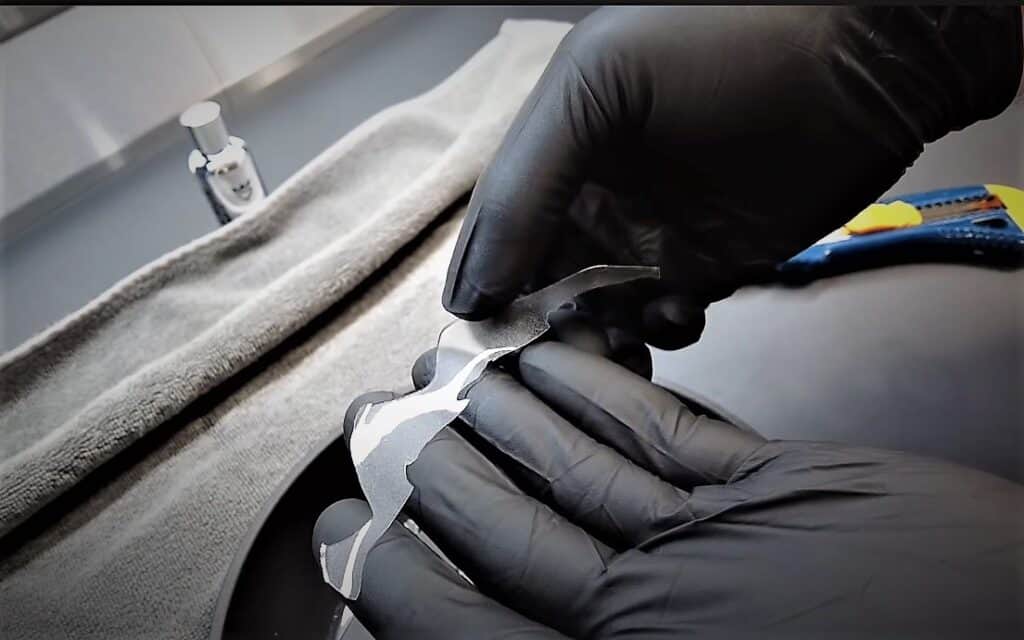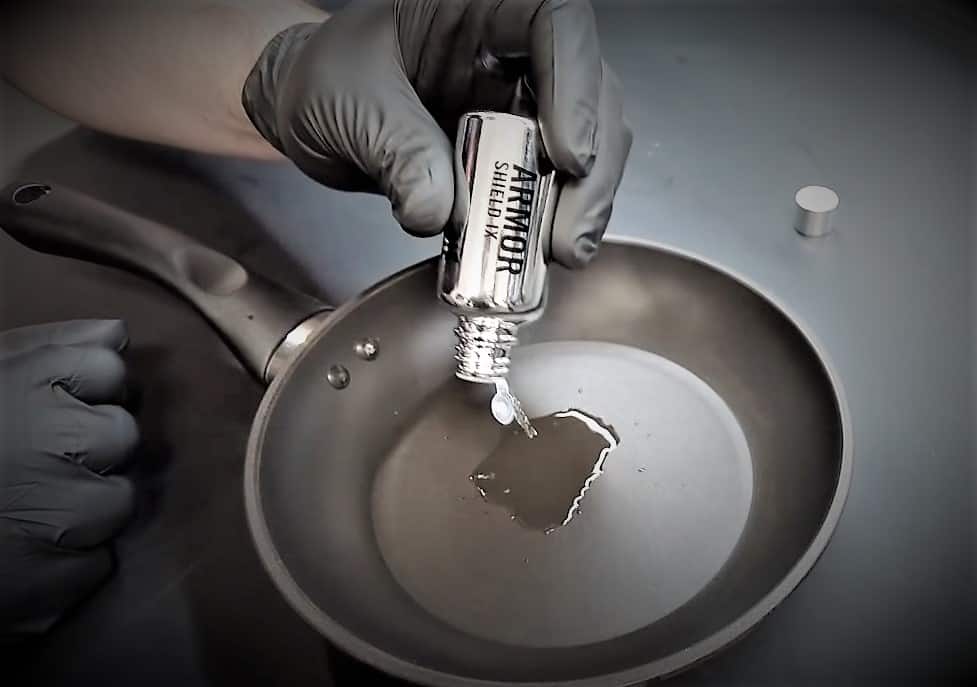May it be the ass-end of an Aston Martin, the chrome handle bars on a Harley Davidson, or the windscreen on a Winnebago, if it’s got a slick, solid surface, there’s a pretty good chance you can ceramic coat it. Every day, more and more DIY enthusiasts are discovering new ways to use ceramic coating too, as one element-repelling protective possibility after another emerges.
But being that ceramic coatings like Armor Shield IX appear completely transparent straight out of the bottle, and cure crystal clear, there is no way to determine exactly what this stuff looks like. Hell, even when examined with the help of an average microscope, the nano particles that comprise a ceramic coating’s genetic structure are almost impossible to see, so forget spotting this stuff with the naked eye!
It was this peculiar conundrum that led one of YouTube’s more inquisitive minds to partake in a very peculiar experiment. He applied ceramic coating to a Teflon pan, in the hopes of collecting a concentrated amount that could be inspected without magnification.
The YouTube mad scientist’s name is Pan The Organizer, and the product he is using for this unorthodox experiment is AvalonKing’s Armor Shield IX. As for the results… let’s just say that you are going to want to see this for yourself.
Who is Pan The Organizer?

Enthusiastic, off-beat, eccentric, hyperactive, hyper-detail-oriented, critical, compelling, and completely obsessed are all descriptors that can be safely applied to Pan The Organizer’s infatuation with car detailing and product testing. He’s the easily excitable nerd in your science class who doesn’t mind helping you prepare for next week’s big exam, and is also a riot to hang out with on weekends. The sort of guy that’s a treasure trove of knowledge, but not the type to be boring about it either.
Since joining YouTube in 2016, Pan has garnered more than 66 million views for his informative, and oftentimes funny car detailing adventures. Over the years, Pan’s following has swelled to over half a million subscribers, with his 20+ years of experience and knowledge providing an abundance of useful knowledge.
In recent years, Pan has delved deeper into experimenting with ceramic coatings, testing both their varying levels of resilience, as well as their ease of application, finish quality, and hydrophobic capabilities.
Quick Nerd Note: Answering pertinent consumer and DIY-related questions has become a cornerstone for Pan The Organizer. So if there’s a topic you feel that should be discussed or a product tested and explored, drop the Canada-based YouTube entrepreneur a line or comment on one of his videos. The guy is forever eager to explore new ideas and products.
Sticking With Pan’s Nonstick Plan

When we approached Pan The Organizer about collaborating on some projects, we were expecting the typical run of application tutorials, durability tests, and product comparisons. We had no idea that this car cleaning enthusiast would be jumping head-first into the silica-filled folds of the ceramic coating epicenter, and creating content that goes well beyond the average detailing video.
So when Pan approached us with a plan to ceramic coat a nonstick frying pan, we were caught a bit off guard. But after explaining his reasoning behind his proposition, and a brief discussion amongst ourselves, the decision to move forward with this nonstick surface experiment was approved.
“Some of the highest, purest silica content that I’ve seen in consumer-grade coating is the AvalonKing Armor Shield IX.”
-PAN THE ORGANIZER
One of the primary reasons Pan approached AvalonKing about using its nano ceramic coating for this little non-stick experiment, was because Armor Shield IX contains around 84% silica, or silicon dioxide (SiO₂). This quartz-based compound is what makes Armor Shield IX so damn strong, which is precisely why Pan The Organizer opted to use it over other products for this experiment. The man was in search of a product that could do the job and therefore set a benchmark, and by Zeus’ beard he sure found it.
Is Ceramic Coating Safe to Apply on Cookware and Other Kitchen Tools?

When we say that you can pretty much coat any hard surface imaginable with Armor Shield IX, we mean it. Now as to whether or not that surface will remain functional, or the coating itself will remain intact depends upon a variety of factors.
Like a Hollywood B-grade actor on a week-long bender, ceramic coatings are incredibly resilient, substance dependent forces of nature. Yet they too have their own inherent weaknesses, and like that struggling film star, will eventually fail to function if pushed too hard for too long.
This leads us to the kitchen, the average human’s second favorite room in the house for experimentation outside of the bedroom. Giggity…
While the majority of people will continue to exclusively ceramic coat their bike, RV, automobile, boat, ATV, or pogo stick, there are a few enterprising souls who have diverged from the norm, and have been ceramic coating items within their home’s interior. In the kitchen, the water and oil repelling benefits associated with a ceramic coating are impossible to ignore, making them an attractive option for those looking to keep surfaces squeaky clean and super glossy.
Kitchen Surfaces That Are Ceramic Coating Friendly
- Oven and microwave doors and faces
- Cabinets and drawers
- Refrigerators and freezers
- Food processors, mixers, and other small kitchen appliances
Essentially, as long as the object in question does not get near the 440° Fahrenheit (226° Celsius) threshold, come into contact with harsh/high pH cleaning chemicals, get inserted in the dishwasher, or come into direct contact with food, you should be golden.

The latter of these items is why Pan The Organizer’s little experiment should be used purely for informational purposes, and not referred to as an approved method for protecting nonstick cookware. In order to guarantee that you are practicing safe ceramic coating procedures, a good rule of wrench is to keep the stuff away from high temp and food prep surfaces, and to never substitute it for a food-safe nonstick cooking spray on a fry pan or any other cooking surface.
Food safety disclaimer complete it’s time to get back to the experiment!
Ceramic Coated Nonstick Cookware Experiment of Utter Awesomeness… Engage!
Early on, Pan The Organizer realized that this little project of his was going to be extremely straightforward, and in keeping with this mindset, we have laid out the following outline. Again, this technique is NOT to be used as a substitute for a traditional, FDA approved nonstick cooking spray or good old-fashioned bacon grease. Mmmmm… bacon grease…..

Steps to Ceramic Coating a Non-Stick Ceramic Frying Pan
- Apply a sizable splash of AvalonKing’s Armor Shield IX to an average, recently cleaned nonstick Teflon frying pan
- Tilt the Teflon coated cookware so that it rests at a slight angle, in order to allow the product to pool to one side
- Cover with a towel to prevent airborne contamination
- Allow the ceramic coating a full 48 hours to cure in a well-ventilated, bone dry enclosed space
- Carefully pry-off the heavily pooled ceramic coating from the nonstick skillet
- Inspect the sliver of solidified ceramic coating, document all findings, and bask in its glory
- Share findings with the rest of humanity and over time become known as “The Godfather of Ceramic Coatings”
Quick Nerd Note: AvalonKing will not be held liable for any ailments resulting from someone eating, snorting, slurping, huffing, gargling, or rubbing Armor Shield IX into their belly button. Not that any of you would actually do that sort of thing, it’s just that after the whole “Gorilla Glue Girl Incident” we’ve come to realize that you can never be too careful.
The Big Pay Off

So exactly what does this stuff look like once it has been allowed to pool-up and solidify atop the Teflon coating? We’d be tempted to say that it looks like a super glossy, crunchy candy shell, but being that we’ve already covered the risks of eating ceramic coatings, let’s just say that it looks like super thin plexiglass.
“Today we showed that you’re actually applying, not vaporware, but actual protection. A little goes a long way.”
-PAN THE ORGANIZER
According to Pan’s findings, his experiment proves that by ceramic coating a surface, you are “…literally adding a film of protection that’s hardened-up.” Pan goes on to say that this non-stick frying pan experiment illustrates that by applying Armor Shield IX to a surface, you are creating an “…awesome barrier of protection that is measurable, and much thicker and harder than your traditional clear coat.”
Parting Shots

So there it is, straight out of the frying pan, and onto the internet. A real world experiment that shows exactly what a layer of 9H-rated, ultra high-end ceramic coating looks like when peeled from a piece of nonstick cookware.
By this point it’s fairly safe to say that Pan The Organizer will likely continue to be a devout advocate for resin delivered, solvent-based paint protectants like ceramic coating. As his nonstick frying pan experiment illustrates, the ability to generate a quartz-based layer of protection has given Pan good reason to refer to silica-rich Armor Shield IX as “…the best form of paint protection.”

“Ceramic coatings are typically 2-3 times stronger and harder than the clear coat that’s on your vehicle. This
-PAN THE ORGANIZERhelps level all of the hills and valleys, because paintwork is never actually smooth… a semi-permanent, hard-shell finish… essentially is what protects your paint against the elements.”
One of Pan’s primary reasons for praising high-end ceramic coatings repeatedly, is due to their hydrophobic properties. This ability to repel repulsive liquids and harmful contaminants is one of the core perks of relying upon nano-technology particles, as they generate what is commonly referred to as “self-cleaning properties,” or “the lotus effect.”
And while the layer of protection most Armor Shield IX buyers will place on surfaces is much thinner, and therefore impossible to safely pry-off and inspect, Pan The Organizer’s creative methods have provided us with an excellent visual of what’s going on behind the scenes. Keep up the good work Pan The Man. We can’t wait to see what you have in store next.













3 comments
Stephen Coats
I have a 2017 Dodge Ram pickup. Can ceramic coating be applied to chrome and glass?
Also some of the chrome on the front of the truck is actually a chrome type coating over plastic that has begun to deteriorate. Can ceramic coating be placed on that material?
I have a 2017 Dodge Ram pickup. Can ceramic coating be applied to chrome and glass?
Also some of the chrome on the front of the truck is actually a chrome type coating over plastic that has begun to deteriorate. Can ceramic coating be placed on that material?
Anthony
Can the spray ceramic be used on the inside of car windows to prevent fogging.?
Will the coating prevent snoe from sticking on glass ?
Just bought the 6 pack and other items yesterday.
Can the spray ceramic be used on the inside of car windows to prevent fogging.?
Will the coating prevent snoe from sticking on glass ?
Just bought the 6 pack and other items yesterday.
Frank J
Can i use this product on my new hundai ionic 5 silver matte paint?
Can i use this product on my new hundai ionic 5 silver matte paint?